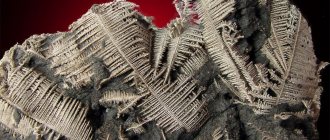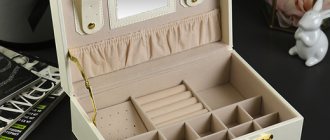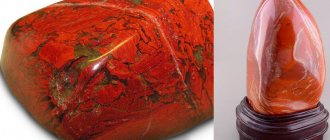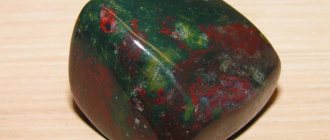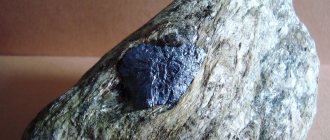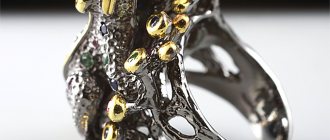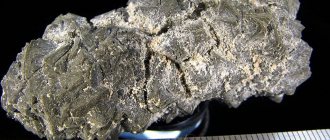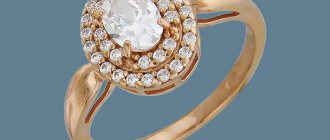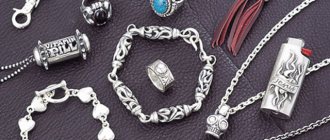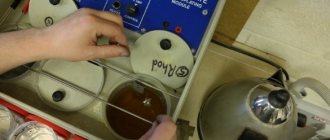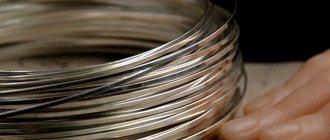What is silver nitrate?
It is not known exactly when, but it is known for certain who discovered this substance. Carried away by the search for the elixir of immortality, Jan Baptiste Van Helmont, the famous Belgian chemist discovered what he believed was one of the components capable of giving a person immortality. Alas, the elixir was probably multi-component, but the resulting salt received a very interesting name - lapis infernalis or “hell stone”.
But that was just the beginning of the story. As it turned out, after continuing his research, Van Helmont discovered that it was silver nitrate that had an antiseptic effect. In large quantities, if it comes into contact with the skin, it causes burns and tissue death. But in small doses or in the form of a solution, it can disinfect the skin and even stop bleeding. In the 16th century, such drugs were valued more than gold.
What does silver nitrate look like?
In fact, the Belgian managed to obtain whitish crystals related to salts of nitric acid containing silver. True, there was not even a hint of silver shine left in the crystals.
Formula and properties
Since silver nitrate is a salt of nitric acid, its formula is expressed as follows:
AgNO3
Where Ag is silver, and NO3 is the remainder of nitric acid. Despite the fact that this is a salt, it has retained many of the properties of the acid itself - HNO3.
As a result of the chemical reaction of acid and silver, a crystalline substance is formed - the crystals are almost regular orthorhombic in shape. Salt has a high density of 4.3 grams per cubic centimeter. This figure is slightly higher than that of other minerals; most salts have a density of up to 3.6 grams per cubic meter. cm.
It is easy to obtain a solution of silver nitrate from salt - it simply dissolves phenomenally in water. At room temperature it dissolves completely. Moreover, just 100 ml can absorb 222 grams of crystals. But dissolution in alcohol is not so simple; only 2.2 grams can be dissolved in 100 grams.
When heated, salt begins to melt at 209 degrees Celsius. At 299 degrees, the decomposition of the substance begins.
Electrolysis of salt solutions
Let's consider the production of silver by electrolysis of its salts. An electrical circuit is assembled in which a galvanic dry element acts as a current source. The maximum current in the circuit should not exceed 0.01 A. When using a dry battery (4.5 V), the current is limited by adding a conductor with a resistance of no more than 1000 Ohms.
Any glass vessel can serve as a bath for the silvering process. The anode of the bath is a metal plate with a thickness of 1 mm and an area slightly larger than that of the part itself. Silver is chosen for the anodic coating. The working solution (electrolyte) for producing silver is a solution of lapis. Before lowering it into the silvering bath, it is necessary to degrease and polish the part, then wipe it with toothpaste.
After removing the fat, it is washed with running water. Complete degreasing can be judged by uniform wetting of the entire surface of the part with water. When washing, use tweezers so that no greasy fingerprints remain on the part. Immediately after washing, the part is fixed on a wire and placed in the bath. The time to obtain silver with a silver anode is 30 - 40 minutes.
If stainless steel is chosen as the anode, then the speed of the process changes. Obtaining silver from nitrate will take 30 minutes.
The part removed from the bath is thoroughly washed, dried, and polished to a shine. When a dark silver deposit forms, the current decreases; for this, additional resistance is connected. This makes it possible to improve the quality of silver production using the electrochemical method. To ensure uniform coating during the electrolysis process, the part is periodically rotated. You can put the metal on brass, steel, bronze.
Preparation of silver nitrate
The traditional method for producing silver nitrate is to dissolve metallic silver in high concentration nitric acid. This is the standard method that the great Belgian himself used. Today, this method is used infrequently, it is very dangerous; during the reaction, nitrogen oxides, a very toxic substance, are formed.
The industry uses a method of etching silver by heating acid. After completion of the reaction, the resulting solution is evaporated to a concentrate. And then the process of crystallization.
New methods eliminate the use of acid concentrate and avoid the evaporation process. For this, a 98% solution of nitric acid is used, and heating is used by releasing the energy of the chemical reaction itself. To do this, ozone O3 is introduced into the solution, and sometimes hydrogen peroxide is used. During the reaction, crystallization of silver nitrate begins immediately.
Methods for removing impurities
Nowadays, you can buy chemical reagents on the open market, so refining silver-plated contacts at home will not be difficult .
It is necessary to follow safety precautions and use respiratory, eye and hand protection.
Carry out reactions with good air exchange, with a hood, or even better - outside. When fusing the resulting metal, observe fire safety.
Refining with electrolyte and ammonium nitrate
The method is suitable for those who cannot purchase and use nitric acid.
The meaning of this reaction is the interaction of ammonium nitrate and sulfuric acid located in the electrolyte with increasing temperature . As a result of heating, a stable compound of nitric acid is obtained, which dissolves the technical silver alloy.
To carry out the reaction you will need:
- chemical resistant glassware;
- sulfuric acid based electrolyte;
- ammonium nitrate;
- electric stove;
- sand bath;
- zinc shavings to highlight metallized silver;
- salt;
- hydrochloric acid;
- hot water.
To successfully carry out the chemical reaction of dissolving 100 g of technical silver, 2 parts of electrolyte (1 liter), 1 part of ammonium nitrate (0.5 kg) are used. The dissolution process takes about 24 hours.
Procedure:
- a glass container (three-liter bottle) is placed in a sand bath heated by an electric stove;
- the recyclable material and reagents are poured into the container: 150 g of saltpeter, 300 ml of electrolyte;
- with increasing temperature, a reaction occurs, boiling is visually observed , the release of a reddish gas, a change in the color of the liquid (a blue tint appears);
- when the dissolution process subsides, chemical components are added in the selected proportion;
- after complete dissolution of the immersed metal, warm water and table salt are used to obtain silver chloride;
- the bottle is filled with H2O almost to the neck, after which salt is added, the amount of which is determined by the end of the precipitation of chloride flakes;
- filtration is performed to separate the silver chloride from the liquid;
- in the same glass container, the resulting white filtered material is poured with hydrochloric acid, the height of the coating is 2 cm above the sediment;
- zinc shavings are poured into the prepared solution, which reacts with HCl and displaces metallized silver, the reaction is accompanied by the release of hydrogen;
- since the gas is explosive, it is necessary to take precautions : ventilation, absence of sources of fire and heating;
- after 20 - 30 minutes an earth-colored precipitate is obtained - this is Ag;
- should be checked for the presence of acid in the solution: it is necessary to dip the Zn shavings into the liquid using tweezers, as a result a dissolution reaction should occur;
- if there is no interaction , then it is necessary to add HCl to the container to remove zinc from metallized silver, so that during alloying you do not get a brittle metal that is not suitable for use;
- the precipitate is washed and fused in a crucible using a gasoline or gas burner.
Scope of application of silver nitrate
First of all, silver nitrate is an excellent reagent and is often used in chemical laboratories for experiments.
In medicine, the substance is used as a local disinfectant. For example, in dentistry, caries is treated with microscopic doses of silver nitrate; salt simply burns out the area affected by bacteria.
By the way, it is known that about 650 types of bacteria and microorganisms are actively destroyed by silver nitrate. Among the diseases in the treatment of which silver nitrate is used are diseases of the internal organs, oral cavity, ulcers, diseases of bone tissue. Silver nitrate is often used to disinfect limb wounds in disaster areas.
Salt-based drugs are produced that ensure the binding of proteins, which in the body are responsible for covering nerve endings. The use of drugs provides an analgesic effect.
Some drugs contain silver nitrate in minute doses. For example, silver nitrate is found in drugs used to treat gastritis. In this case, the permitted age of use starts from 3 years.
In everyday life, people indirectly encounter silver nitrate almost every day. When buying a newspaper or opening a book, few people realize that in printing, silver nitrate is used for etching the original proofs - the plates from which newspaper issues are printed.
Silver nitrate is used in printing
Even when wearing a T-shirt with a bright print, it is difficult to guess that silver nitrate is also used to apply the design to the fabric or leather.
Silver nitrate is used in the production of higher capacity batteries. Ocean-going ships and submarines cannot do without such batteries.
The manufacture of lenses for binoculars, telescopes, optical instruments and even ordinary light-protective glasses cannot be done without treating the glass with silver nitrate. Even in a lady's handbag where cosmetics are stored there is glass treated with nitrate - a mirror. What can we say about scientific telescopes, which have simply fantastic mirror diameters.
However, a number of tasks for this substance are consigned to history. Today, with the massive transition from conventional film cameras to digital ones, the very concept of photography as an art is disappearing into oblivion. And along with this era, an important area of application of silver nitrate is disappearing - photoreagents.
But for jewelers, the damn stone will always be important - it is used to process costume jewelry and jewelry.
Origin of the element
Silver has been known to mankind since ancient times, and it is difficult to name the exact date of discovery of the metal. Many written sources confirm that silver jewelry was made in ancient Egypt, when silver was a rarer metal than gold and was much more valuable.
The first silver mines were founded by the Phoenicians BC. In Europe, there was also development of the precious metal, which was used primarily for making jewelry.
There is a reason why people valued silver so highly. At that time, people knew only native metal, the search and extraction of which was very difficult. The development of the element was hampered by sulfide, which covered the silver nuggets with a dark coating. A turning point in the history of silver mining was the experiments carried out by medieval alchemists. The purpose of the experiments was one - to obtain gold from any other metal. It was thanks to alchemists that Europeans learned to extract silver from metal compounds with other chemical elements (chlorine, arsenic, etc.).
Scheele, Paracelsus and other ancient scientists played a significant role in the history of silver production. They confirmed the fact that silver has disinfectant properties discovered in ancient times. Egyptian healers also used plates of this precious metal to treat ulcers: the bactericidal properties of silver did not allow the wounds to fester.
The unique qualities of the precious metal were appreciated by the aristocracy, who used expensive silverware. By that time, it was possible to improve methods of metal extraction, which led to its reduction in price. Silver began to be used as a means of payment, making coins from it. The Russians owe the name of the state currency to silver: for payments they used silver bars, cutting off the required part from them. This is how the word “ruble” came into use.
Silver nitrate price
When it comes to the price of this dangerous substance, you need to understand for what purpose and in what volume the reagent is purchased. For individual use, you can buy salt in small quantities. Many enterprises offer small volume packaging - 40-50 grams. But this is for individual buyers. For enterprises and organizations, the volume of supplies is specified in tons or even tens of tons.
Prices for the drug offered today for individual buyers:
- Packaged in 1 gram – from 40 rubles;
- Packaging up to 50 grams – from 43 rubles per gram;
- For industrial consumers the price is 41,900 rubles per kilogram.
In Moscow you can buy silver nitrate at a price of 32 rubles per 1 gram*.
Preparation of silver nitrate
The preparation of silver nitrate in the laboratory is usually carried out with the strictest precautions. The fact is that the work involves the use of acid and the release of a large number of toxic substances during the reaction. Therefore, it is necessary to prepare the workplace for the experiment:
- It is necessary to clean the work area from foreign substances, especially those containing alkalis;
- Turn on the hood;
- Wear safety glasses to protect your eyes;
- Wear a filtration mask or facepiece respirator;
- To protect your hands, you should use laboratory gloves and a gown.
- You cannot conduct the experiment in shorts, flip-flops or bare feet.
When creating silver nitrate, you must wear safety glasses and a respirator.
To work, you need a ventilated room and a wide laboratory table.
The influx of clean air and the removal of contaminated air is an important point in the preparation of silver nitrate - during the reaction, a large amount of toxic steam is released, which quickly reaches a lethal concentration in a closed room. It is imperative that people around you be warned about your intention to work with nitric acid. This will help to avoid injuries on the one hand, and if there is a threat to life, then someone will definitely help and call for help
Recommendations
Since work is carried out with aggressive chemicals, it is necessary to strictly follow the safety rules:
- be sure to ensure good ventilation of the room (it is better to work outdoors);
- use skin and mucous membrane protection: gloves, goggles, masks or gauze bandages;
- add only acid to water, never the other way around.
- check for the presence of a chemical reagent by dropping the shavings using tweezers. If it does not dissolve, add HCl to remove zinc from the deposited metal.
You can make good money by purifying silver and refining it. The profit in this business will be many times greater than the costs.
Source
